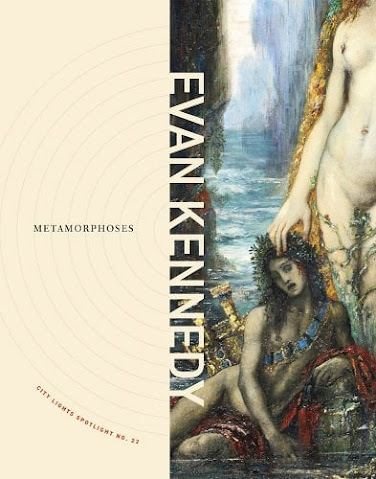Evan Kennedy, METAMORPHOSIS
TREE OF LIFE
In the tree of life I losemy way
upper branches tangledvines self-reflected creation
it’s not my intention toforget my origin
a sunbeam illuminates me
my descendants inferiorsin branches below
my own face bloomingsmiling cawing
I was birthed raised frombelow
lifted onto a branch thenfell into gravity’s biomass
The tree of life calls tome inscribes my lineage
ears enclose a sonicglobe
beside me mycontemporaries
close relations withintouch while
I jump swing fly toothers farther away I resemble less
Hold onto that imagerecite it
I wait for these branchesto be canceled
entire history existentwithin me
my identity compriseslife nothing more
my appearance is its alteration
 Thelatest from San Francisco-based “poet and bicyclist” Evan Kennedy is
METAMORPHOSIS
(San Francisco CA: City Lights Books, 2023), published as the twenty-secondtitle in the “City Lights Spotlight” series. Kennedy is also the author of ahandful of prior titltes that I seem to have (frustratingly) missed, including
Shoo-Insto Ruin
(Gold Wake Press, 2011),
Terra Firmament
(Krupskaya, 2013),
The Sissies
(Futurepoem, 2016), Jerusalem Notebook (O’clock Press, 2017)and
I am, am I, to trust the joy that joy is no more or less there now than before
(Roof Books, 2020). The lyrics that make up Kennedy’s METAMORPHOSISslant and slash, each composed as monologues exploring voice, through Ovid, oraclesand Apollo to the very nature and possibility of change. Kennedy threads threepoems with the same title, “Tree of Life,” through the collection as a kind oftether, threading a prompt led by Ovid himself. “I’m not pursuing / you exactlybut resemblance through subjectless tissue / and muscle,” Kennedy writes, toclose the poem “TO OVID,” “expanding grim tradition to keep leopards happy /lounging in mossy temples long after belief.”
Thelatest from San Francisco-based “poet and bicyclist” Evan Kennedy is
METAMORPHOSIS
(San Francisco CA: City Lights Books, 2023), published as the twenty-secondtitle in the “City Lights Spotlight” series. Kennedy is also the author of ahandful of prior titltes that I seem to have (frustratingly) missed, including
Shoo-Insto Ruin
(Gold Wake Press, 2011),
Terra Firmament
(Krupskaya, 2013),
The Sissies
(Futurepoem, 2016), Jerusalem Notebook (O’clock Press, 2017)and
I am, am I, to trust the joy that joy is no more or less there now than before
(Roof Books, 2020). The lyrics that make up Kennedy’s METAMORPHOSISslant and slash, each composed as monologues exploring voice, through Ovid, oraclesand Apollo to the very nature and possibility of change. Kennedy threads threepoems with the same title, “Tree of Life,” through the collection as a kind oftether, threading a prompt led by Ovid himself. “I’m not pursuing / you exactlybut resemblance through subjectless tissue / and muscle,” Kennedy writes, toclose the poem “TO OVID,” “expanding grim tradition to keep leopards happy /lounging in mossy temples long after belief.” METAMORPHOSIS is a southern California poem of temporalshifts, and ghosts both new and old, offering a lyric examination of transformation,queerness, collapsing empires, the ecological present and a range of popculture references to anchor each moment. Kennedy digs his layers deep intoantiquity, simultaneously overlapping a contemporary San Francisco throughwriting the minotaur, Phaethon, Keats and Judy Garland, Roman household godsand Madonna. There is a great deal of play here, blended with an anxiety forthe future while slipping through and across identity and possibility. Through Kennedy’sdeft hand, this book length poem is already more than it already is.



